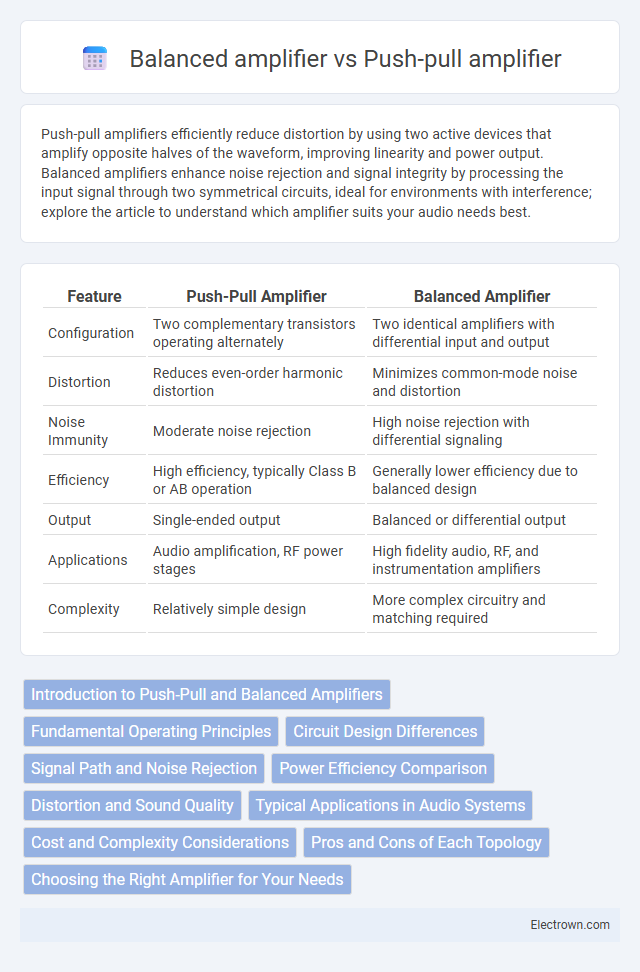Push-pull amplifiers efficiently reduce distortion by using two active devices that amplify opposite halves of the waveform, improving linearity and power output. Balanced amplifiers enhance noise rejection and signal integrity by processing the input signal through two symmetrical circuits, ideal for environments with interference; explore the article to understand which amplifier suits your audio needs best.
Table of Comparison
| Feature | Push-Pull Amplifier | Balanced Amplifier |
|---|---|---|
| Configuration | Two complementary transistors operating alternately | Two identical amplifiers with differential input and output |
| Distortion | Reduces even-order harmonic distortion | Minimizes common-mode noise and distortion |
| Noise Immunity | Moderate noise rejection | High noise rejection with differential signaling |
| Efficiency | High efficiency, typically Class B or AB operation | Generally lower efficiency due to balanced design |
| Output | Single-ended output | Balanced or differential output |
| Applications | Audio amplification, RF power stages | High fidelity audio, RF, and instrumentation amplifiers |
| Complexity | Relatively simple design | More complex circuitry and matching required |
Introduction to Push-Pull and Balanced Amplifiers
Push-pull amplifiers use two active devices that alternately amplify opposite halves of the input signal, significantly reducing even-order harmonic distortion and improving efficiency. Balanced amplifiers employ two identical amplifier circuits arranged in a way that cancels common-mode noise and interference, enhancing signal purity and noise immunity. Both configurations aim to improve linearity and performance but differ in topology and specific applications within audio and RF amplification.
Fundamental Operating Principles
Push-pull amplifiers operate by using two transistors that alternately amplify opposite halves of the input signal waveform, reducing even-order harmonic distortion and improving efficiency. Balanced amplifiers utilize a pair of amplifier circuits arranged with phase-splitting and recombining networks to cancel common-mode signals, enhancing noise rejection and linearity. The push-pull configuration emphasizes distortion reduction through complementary signal processing, while balanced amplifiers focus on noise immunity through differential operation.
Circuit Design Differences
Push-pull amplifiers use two active devices that amplify opposite halves of the waveform, minimizing even-order harmonic distortion and improving efficiency through complementary transistor operation. Balanced amplifiers employ two identical amplifier circuits driving separate outputs, often with a transformer or phase splitter to achieve balanced signals, resulting in superior common-mode noise rejection. The core design difference lies in push-pull's complementary device pairing versus balanced amplifier's dual matched circuit topology for signal symmetry.
Signal Path and Noise Rejection
Push-pull amplifiers utilize two active devices operating in opposite phases to amplify the signal, resulting in a signal path that cancels even-order harmonics and reduces distortion. Balanced amplifiers employ differential signal paths with matched components, enhancing common-mode noise rejection and minimizing interference. The superior noise rejection in balanced amplifiers stems from their ability to reject signals common to both inputs, making them ideal for high-precision audio and RF applications.
Power Efficiency Comparison
Push-pull amplifiers typically achieve higher power efficiency, often ranging between 60% to 70%, by utilizing both halves of the input signal and reducing distortion through complementary transistor operation. Balanced amplifiers, while offering superior signal symmetry and noise rejection, generally exhibit lower power efficiency around 50% to 60% due to the inherent complexity of their dual signal paths and additional circuitry. The efficiency advantage of push-pull designs makes them preferable in high-power audio and RF applications where energy conservation is critical.
Distortion and Sound Quality
Push-pull amplifiers reduce even-order harmonic distortion by using two complementary transistors that cancel out distortion components, resulting in cleaner sound with improved linearity. Balanced amplifiers offer superior common-mode noise rejection and lower distortion by driving the output with two balanced signals, enhancing sound clarity and dynamic range. Both topologies improve sound quality, but balanced amplifiers typically provide more precise audio reproduction in high-fidelity applications.
Typical Applications in Audio Systems
Push-pull amplifiers are commonly used in high-power audio amplification where efficiency and reduction of even harmonic distortion are desired, such as in home theater systems and guitar amplifiers. Balanced amplifiers find typical applications in professional audio environments, including microphone preamplifiers and studio mixing consoles, due to their superior noise rejection and improved signal integrity. Both amplifier types enhance sound quality by minimizing distortion, but push-pull designs excel in power handling, while balanced amplifiers prioritize noise reduction.
Cost and Complexity Considerations
Push-pull amplifiers generally have lower cost and simpler design due to fewer components and straightforward circuitry, making them suitable for budget-conscious applications. Balanced amplifiers involve more complex configurations with additional transistors and balancing networks, increasing both manufacturing expenses and design complexity. When selecting an amplifier for your project, consider push-pull options for cost efficiency and balanced amplifiers when advanced performance justifies higher complexity.
Pros and Cons of Each Topology
Push-pull amplifiers deliver high efficiency and reduced even-order harmonic distortion by using two transistors operating in opposite phases, making them ideal for power applications but can introduce crossover distortion at low signal levels. Balanced amplifiers offer superior noise rejection and signal symmetry by using differential inputs and outputs, enhancing audio fidelity at the cost of increased circuit complexity and component count. Your choice depends on whether efficiency and power or noise performance and linearity are prioritized in the specific audio or RF application.
Choosing the Right Amplifier for Your Needs
Push-pull amplifiers offer excellent distortion cancellation and higher efficiency, making them ideal for applications requiring clean, powerful output with fewer harmonic distortions. Balanced amplifiers provide superior noise rejection and signal integrity, particularly suited for sensitive audio or communication systems where minimizing interference is critical. Your choice depends on whether you prioritize power efficiency and harmonic reduction (push-pull) or noise immunity and signal clarity (balanced).
Push-pull amplifier vs balanced amplifier Infographic

 electrown.com
electrown.com